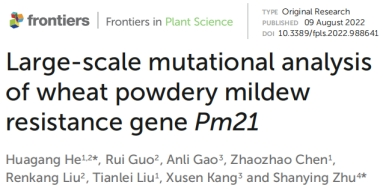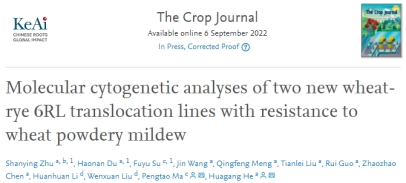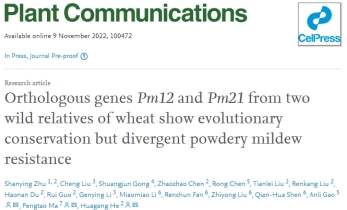Wheat powdery mildew is an epidemic fungal disease caused by Blumeria graminis f.sp. tritici. It is one of the main diseases affecting wheat production and widely occurring in wheat regions in China and the world. Cultivated wheat has a large number of wild relatives, which are valuable resources in wheat breeding for resistance to powdery mildew.
Recently, He Huagang and his team, together with Henan University, Yantai University, Shandong Academy of Agricultural Sciences, Hubei Academy of Agricultural Sciences, and Institute of Genetics and Developmental Biology, Chinese Academy of Sciences, have made a lot of progresses in the research of wheat powdery mildew resistance, and the relevant results have been published in internationally influential journals.
On August 9th, 2022, Frontiers in Plant Science (JCR Q1, IF 6.627) published a research paper titled "Large-scale mutational analysis of wheat powdery mildew resistance gene Pm21," In this paper, 59 functional sites of powdery mildew resistance gene Pm21 were reported, and their distribution was revealed. One mutation hotspot and one dominant negative effect site were found, which laid the foundation for further study on the structure and function of resistance protein.


A newly discovered mutation hotspot
On September 6th, 2022, the research paper was published online in The Crop Journal (Excellence Program Journal, JCR Q1, IF 4.647) under the title "Molecular cytogenetic analyses of two new Wheat-Rye 6RL translocation lines with resistance to wheat powdery mildew ". In this study, two wheat-rye 6RL translocation lines carrying new powdery mildew resistance sites were created and identified by remote hybridization, and 6RL-specific KASP marker was developed to accelerate the breeding utilization of 6RL new translocation lines.


Powdery mildew resistance and agronomic traits of new species
November 9th, 2022, in Plant Communications (High Start Journal of Excellence Program, JCR Q1, IF 8.625) on the Internet titled Orthologous genes Pm12 and Pm21 from two wild relatives of wheat show evolutionary conservation but In the paper of divergent powdery mildew resistance, the cloning and functional identification of the broad-spectrum powdery mildew resistance gene Pm12 from S. pseudospelderia revealed the differences in the specificity of small species identification of Pm12 and its direct homologous gene Pm21. And the differences in the patterns of intramolecular interactions between the encoded proteins, also revealed the evolutionary characteristics of Pm12/Pm21 sites in triticeae. The cloning of Pm12 will greatly promote its application in wheat breeding for resistance to powdery mildew and accelerate the analysis of its resistance mechanism.

 Cloning and functional identification of Pm12
Cloning and functional identification of Pm12

Comparative analysis of PM12 and PM21 induced cell death and protein intramolecular interactions
Liu Tianlei, Wang Jin, Meng Qingfeng and master student Chen Zhaozhao participated in parts of the research works.